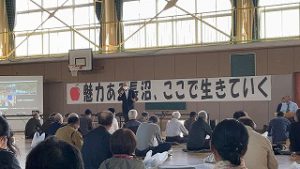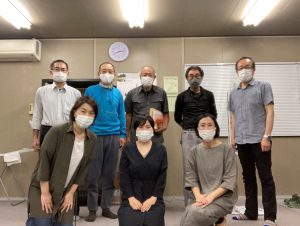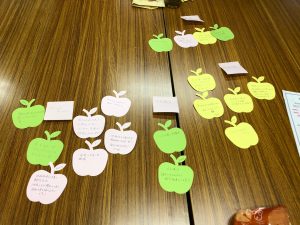Many Actions, One Voice – Community Recovery Committee of Naganuma [Japan/Nagano]
On 24th April this year, the seventh Naganuma district whole-town meeting for disaster recovery was organized. In this meeting, the District Community Council and the District Disaster Recovery Planning Committee discussed the importance of a collaborative approach towards recovery of the community.

Whole-town meeting in April 2021
In Naganuma district, the Disaster Recovery Planning Committee was established to take charge of liaison with external stakeholders including local and national government bodies regarding reconstruction after Typhoon Hagibis in 2019. Under the umbrella of the District Community Council, the Committee has three focal areas for discussions and coordination, namely, 1. Reconstruction of the river dike along the Chikuma river and planning of the “disaster risk reduction station” as part of the reconstruction, 2. Improvement of the surrounding area of Naganuma Elementary School, and 3. Establishing public housing units for affected residents within the district.
A year and half have passed since the typhoon disaster, which has seen individual residents in various stages of recovery, and has led them to take their own decisions. Some of them have decided to rebuild their houses within the district, while others have found it challenging to determine where they would resettle or relocate. The bonds among residents that existed before the disaster cannot be rebuilt as easily as tangible/physical structures. Recovery of the community in this sense is essential in order to make the Naganuma district sustainable in the long run, especially with escalating depopulation after the disaster. The community contains both existing neighborhood bonds from pre-disaster times, and new connections that have been created because of the disaster, i.e. volunteers and visitors.
In order to meet this challenge in pursuit of recovery of the community, “Community Recovery Subcommittee” was launched earlier this year, under the Disaster Recovery Planning Committee of the district. The subcommittee is composed of selected representatives from the four areas under the district, the Chairs of the Community Council and Disaster Recovery Planning Committee, and SEEDS Asia.

Members of the Community Recovery Subcommittee
The disaster impacted the four areas, namely, Omachi, Hoyasu, Tsuno and Akanuma, differently. The respective areas also possess distinctive historical and cultural assets. However, solidarity as Naganuma district as a whole is vital in order to realize a common future for disaster recovery, as the coordination to work with external stakeholders is essentially done at the district level. This solidarity is only possible when each of the residents can have their voices heard, and the dots (that is, the small independent initiatives towards recovery taking place all over the districts) are connected to create a holistic picture of Naganuma’s future.
Therefore, the Community Recovery Subcommittee gathers monthly both online and offline to plan and implement initiatives to collect and visualize the voices of the residents. What they like about Naganuma, what challenges they are facing, and what kind of action they want to take – these opinions are being collected using a tool called the “Apples for Disaster Recovery and Community Development” (as apples are one of the most well-known products of the district). Pilot-testing with the cooperation of the Naganuma Elementary School is currently ongoing, and eventually, it is hoped that every single resident will be able to voice their true feelings about their hometown, so that community development initiatives can be implemented with a sound grounding for the true benefit of residents.

Apple for Disaster Recovery and Community Development cards